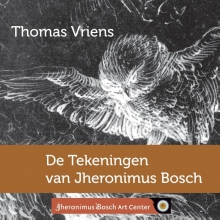
Vriens 2016
De Tekeningen van Jheronimus Bosch (Thomas Vriens) 2016
[Uitgeverij CABV, s.l. (’s-Hertogenbosch), s.d. (2016), 80 pages]
In this modest booklet Vriens introduces the drawings attributed to Bosch (17 sheets, 26 drawings including the reverse sides) to a general public. In the introduction he writes: ‘But the drawn oeuvre as a whole has been described only once and that was clearly intended for the specialized reader. This booklet mainly hopes to meet the wishes of a more general public: complete, convenient and understandable’. That only one monograph has been written about Bosch’s drawings in the past (as is also signalled on page 80) is not completely true (there is Charles van Beuningen, The Complete Drawings of Hieronymus Bosch, 1973 as well), but obviously the author here refers to Koreny (see Koreny 2012). Vriens shies away from engaging in a debate with Koreny and so he does not pay any attention to the issues of dating and authenticity regarding the drawings. In the bibliography, on page 80, he only claims off-handedly that Koreny’s ‘major conclusions are seriously being doubted by most experts’.
According to Vriens Bosch is not only unique as a painter, but also as a draughtsman he has been of major importance as one of the founding fathers of drawing as an independent medium of art. Although the drawings’ comments remain rather superficial the text as a whole makes a sound impression. In between the analyses of the drawings the reader can further enjoy some interesting information about related issues: methods of drawing, paper and watermarks, signatures and captions, connoisseurship, underdrawings and the case of the Pedlar triptych whose central panel has been lost and whose wings have been separated (front sides from reverse sides). Page 61 (in the chapter about connoisseurship) has a sentence that can be framed and hung on the wall: ‘Generally speaking an art historian acts wisely when his conclusions are reserved’.
Some remarks with respect to the book’s content. On page 45, at least in my opinion, the hypotheses of Ilsink 2009 regarding the The Field has Eyes drawing are too easily taken for granted. I do not see how Vriens can know that the Tree-Man drawing (Vienna) has ‘undeniably’ been influenced by the Tree-Man in the Garden of Delights and not vice versa [p. 57]. Every now and then the author seems to be jumping to conclusions when he notices allusions to unchastity (for instance on p. 15 regarding the Paris Witches drawing, on p. 17 regarding the Witch and a Man in a Beehive drawing and on p. 19 regarding the bird-devil sitting on a potty-chair in the Garden of Delights). Page 44 seems to have an observational error in claiming that the rooster in the The field has Eyes drawing ‘is careless enough to enter’ (the fox’s hole). Is this rooster not lying on the ground, meaning that he is already dead and has been careless long before?
In the case of a second edition one occasional mistake and a number of linguistic errors can perhaps be corrected. On page 17, for instance, the illustration (a detail from the Venice Hermits triptych) has a wrong caption. Bad grammar occurs more frequently (for examples, see the Dutch version of this review).
[explicit 15th June 2016]